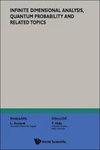距离正则图上吉布斯态的正性
IF 0.8
4区 数学
Q4 MATHEMATICS, APPLIED
Infinite Dimensional Analysis Quantum Probability and Related Topics
Pub Date : 2021-11-03
DOI:10.1142/s0219025722500266
引用次数: 3
摘要
我们研究了确保距离正则图上的吉布斯态(通常也称为广义真空态)是正的准则。我们的主要标准假设图可以嵌入到一个不断增长的距离正则图族中。为了证明这个正性,我们使用多项式超群理论,并将这个正性转化为对于x∈[−1,1],函数n7→xn是否具有正的积分表示,即与图相关的正交多项式。我们将我们的标准应用于几个例子。对于Hamming图和无限距离传递图,我们得到了正Gibbs态的完整描述。本文章由计算机程序翻译,如有差异,请以英文原文为准。
POSITIVITY OF GIBBS STATES ON DISTANCE-REGULAR GRAPHS
We study criteria which ensure that Gibbs states (often also called generalized vacuum states) on distance-regular graphs are positive. Our main criterion assumes that the graph can be embedded into a growing family of distance-regular graphs. For the proof of the positivity we then use polynomial hypergroup theory and translate this positivity into the problem whether for x ∈ [−1, 1] the function n 7→ xn has a positive integral representation w.r.t. the orthogonal polynomials associated with the graph. We apply our criteria to several examples. For Hamming graphs and the infinite distance-transitive graphs we obtain a complete description of the positive Gibbs states.
求助全文
通过发布文献求助,成功后即可免费获取论文全文。
去求助
来源期刊
CiteScore
1.50
自引率
11.10%
发文量
34
审稿时长
>12 weeks
期刊介绍:
In the past few years the fields of infinite dimensional analysis and quantum probability have undergone increasingly significant developments and have found many new applications, in particular, to classical probability and to different branches of physics. The number of first-class papers in these fields has grown at the same rate. This is currently the only journal which is devoted to these fields.
It constitutes an essential and central point of reference for the large number of mathematicians, mathematical physicists and other scientists who have been drawn into these areas. Both fields have strong interdisciplinary nature, with deep connection to, for example, classical probability, stochastic analysis, mathematical physics, operator algebras, irreversibility, ergodic theory and dynamical systems, quantum groups, classical and quantum stochastic geometry, quantum chaos, Dirichlet forms, harmonic analysis, quantum measurement, quantum computer, etc. The journal reflects this interdisciplinarity and welcomes high quality papers in all such related fields, particularly those which reveal connections with the main fields of this journal.

 求助内容:
求助内容: 应助结果提醒方式:
应助结果提醒方式:


